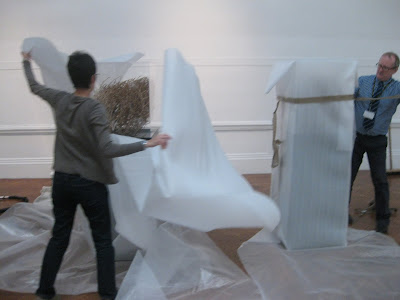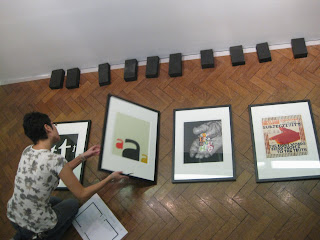Although I have only written about my curatorial conception of the Text Festival exhibitions once before they actually open, it feels like it is a tradition that I should continue with the forthcoming displays. In this, I’m mainly thinking about the Bury Art Gallery shows, Wonder Rooms and Sentences. I’ll write about A Map of You, TradeStamps, and Requiem another time.
Preparing for this the third festival, it occurred to me that while previous TF displays included examples of visual poetry, no show so far has directly addressed the question of the location of visual poetry in a gallery. My conception for the show has developed from my responses to the dynamics and location of visual poetry itself. The first thing that seemed obvious is the disconnection of visual poetry from visual art. I am not aware of many (any?) exhibitions of visual poetry qua visual art curated by a curator in an art gallery. Since the 1960’s and conceptual art, text-based work in contemporary art galleries is been ubiquitous; for a while I used to play a little mental game when visiting galleries – how long does it take to come upon a text work? After a while I gave it up because it became repetitive: but tellingly, they were unremittingly not works located in or even tangentially connected to a poetry tradition. As Christian Bök observes in the Harriet Blog about the Text Festival: “While we might expect poets to upstage all other artists in the use of language as an artful medium, few poets of advanced, literary renown have ever enjoyed the level of either artistic prestige or monetary success, typically experienced by any famous, visual artist who uses language in a gallery exhibit.”
It’s actually worse than that. As I have blogged previously, contemporary poetry is so disconnected from contemporary art that it is practically invisible. I could digress (again) into the problem of galleries deploying poets as event decoration which actually proves the point in the vacuous names they choose – eg Simon Armitage at Yorkshire Sculpture Park or Carol Ann Duffy at Tate Liverpool. Even probably the most famous curator Hans Ulrich Obrist’s Poetry Marathon at the Serpentine in 2009 failed to unpick the inherent alienation. One of the poets who performed at the Marathon, Caroline Bergvall (who is perhaps the most successful poet in contemporary art nexus – and by the way one of the first commissions in the first Text Festival) observed of the Marathon experience:
“Although a number of the chosen artists are known for dealing with writing and language pertinently and intrinsically as part of their artwork (Susan Hiller, Tacita Dean, Sean Landers, Jimmie Durham, Jonas Mekas, Dominique Gonzalez-Foerster), it was something of a disappointment to see so many of them react with undisguised anxiety at that same word, ‘poetry’. Otherwise lucid, articulate artists found themselves in the throes of open self loathing, ‘I don’t know poetry’, ‘I don’t know what to read’” and “it seems to me that the event confirmed that the debates between art and poetry remain superficial and usually kept on a back foot, or at arm’s length.”
It is at the conceptual end of the poetry spectrum where it feels that the dialogue can engage most easily with contemporary art practice – and I’ll return to this in discussing Sentences. But the curatorial question of visual poetry remains: what are the dynamics of display for a visual form that is peripheral in the infrastructure of visual exhibition?
In attempting to answer this question (and I am not claiming my answer is the only answer), I apprehended a number of considerations – some are generalisations which may not apply to a particular individuals but are I think observable across the piste. The first is the prolific productivity which seems to characterise most vispo practitioners. Unlike other artistic practice, visual poets tend to generate many interpretations, editions or versions of the same work; though not necessarily common, some vispo artists treat the multiple versions as a rhythmic or serial single work. A second observation was the global ubiquity of visual poetry: as soon as you start looking for visual poets or invite submissions you find them everywhere. So one subsidiary question that floated around for a while was: are there national or regional stylistic differences? Are there even dialects of vispo? As I have curated Wonder Rooms, this has become less relevant. Parsing such subtleties proves difficult given that a significant driver of vispo production and distribution is the internet. It is noticeable that so much of the work is designed with software and ‘shown’ online, which in itself introduces another aspect related to scale. Seeing their precedents in poetry and hence the page, and then working for the screen, many visual poets do not have a specific sense of how their work should exist off-line. A lot of work came to me with no stipulation as to how big it should be printed or on what type of surface. This is not a criticism, just an observation of a dynamic in the form, which impacts on how it can function in a visual arts context in which scale in space is part of the vocabulary of reception. Then finally when I could find representations of other visual poetry displays, which tend to be curated by visual poets: I looked at what these implied about vispo’s interpretation of how vispo functions in a space.
The challenge is summed up by Christian Bök’s comment: “The visual artist might produce a linguistical installation that gets presented at a glamorous, grandiose scale—but to poets, such an installation might often appear “unpoetic” in its use of language, missing obvious chances to demonstrate the kind of artful merits, seen in the most expert usages of both concise rhetoric and unusual metaphor. The poet might deploy language more artfully than the visual artist—but alas, poets seem to be incapable of filling the white cube of the gallery with their own words, since poets lack the stylistic expertise that might give them access to the “vocabularies” of novelty, glamour, and fashion, required to address the world of art with an impressive, innovative gesture.”
So these were the elements that Wonder Rooms set out to address – production and distribution factors, display assumptions (of individual works and works in spaces) and then finally the specific location of visual poetry in Bury Art Gallery in its dialogue with Sentences (and to a lesser extent with the other shows in the festival).
My initial solution is implied in the title – the urge to ‘over-production’, the geographical ubiquity, the alienation of scale – suggested a cabinet of curiosities style installation. Not only was this inherent in the vispo landscape, but it also challenges the expectation of display as restrained in the minimalism of the white cube. Again, generally, on the odd occasion when vispo is curated it seems routed in a static idea of curating, a response to space that is inherited from galleries seen, rather than an engagement between the work and spatial immanence. Although it was my intention to pack the show to the roof, but as Picasso once advised, you should avoid the seductions of pretty ideas. So as the mass of works came to be laid out in the room, a new dynamic imposed itself – rooted in the original Wunderkammer idea but taking the visitor/reader through the space as an interweaving of vispo styles, methods of production, technologies, ideas exchanged in juxtaposition, and curatorial judgements about how blocks of works, colours, eye-lines, desire paths enhance the experience of passing through the space.
For the Sentences show, I set out to investigate the problem from a different direction. In looking at how conceptual artists have approached language in art, the simple observation is their tendency towards the sentence as the unit of composition – which is a relatively straightforward place for poets since LANGUAGE. And in consideration of the lack of stylistic expertise that might give poets “access to the “vocabularies” of novelty, glamour, and fashion, required to address the world of art with an impressive, innovative gesture”, I commissioned and sourced poets noted for their work with sentences treated with equality to text-based artists. I’m particularly pleased to be the only context that has commissioned Ron Silliman to create a gallery work; more than that, his neon text has been conceived as a piece of public art which will be repositioned after the exhibition to become a permanent feature at Bury’s Tram Station. Curatorially, this show was conceived to be a significantly minimalist hang to counter balance the excess of the Wonder Rooms show; though to establish a dialogue between the two spaces, a little of the latter style bleeds over into Sentences.

Anyway, there are a number of other ideas which inform the inclusion of Pavel Buchler’s Studio Schwitters, Christian Bök’s Protein 13, Holly Pester’s Text Festival archival work, etc. but I will leave these for visitors to experience. Let’s just say, I endorse Art Monthly’s review comment of the 2009 Text Festival’s “intrepid resistance to interpretation”.



























